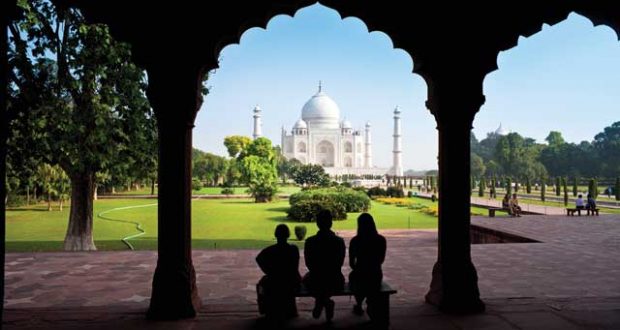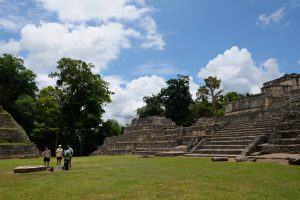
This mausoleum is so iconic that it borders on cliché. However, glimpsing the Taj Mahal is enough to blast away any lingering cynicism
View online at natgeotraveller.co.uk
“He cut off the hands of all the architects so the Taj Mahal could never be replicated or rivalled,” a chai wallah tells me in Delhi, handing me a steaming cup of tea. He chops at one wrist with his other hand to illustrate his point. Behind me in the queue, a woman tuts audibly. “Don’t listen to him,” she says conspiratorially, drawing closer. “That’s nonsense. He gouged out their eyes!” The debate slips into animated Hindi and I creep back to my auto-rickshaw. But my route onwards from India’s capital to Agra is paved with more sensational stories. Strangers’ ears prick up when I mention my destination. Over 350 years have passed since Mughal emperor Shah Jahan built a mausoleum for his beloved wife. But when it comes to the Taj Mahal, the rumour mill is still grinding.
“You can discard those stories,” says my guide, Nishant, when he picks me up in Agra. “He just kept the designers’ names out of the official records, but the violence does make for a good tale.”
Nishant has promised to sift through the legends and dish out the facts. But he looks pained when I suggest that the romantic story behind the Taj Mahal’s construction is just another exaggerated tale. A battle between indignation and politeness plays out across his features. “It’s the greatest love story in the world. Madam, I don’t think you’ll feel so cynical when we get there. Only love could have built such a place.”
When we arrive at the security check on the monument’s outskirts, macaques almost outnumber staff. They charge across the tin roofs, making a noise that sounds like thunder. They’re hoping to be fed the food confiscated from tourists’ bags (“Free continental breakfast!” Nishant jokes). We take our time approaching the sandstone Chowk-i-Jilo Khana gatehouse, pretty enough in itself to be the main event. But my mind is elsewhere. I’ve grown up with images of the Taj Mahal — it’s the symbol of India, a byword for the glorious vestiges and exotic beauty of the subcontinent. Will it feel familiar? Humdrum, even?
“Ready?” Nishant asks.
Framed in the dim, rust-red, arched gateway is an otherworldly vision. White minarets, balconies, onion domes and golden finials sing to each other against a pale sky. I move forward into the light. Verdant lawns and dark poplars are divided by turquoise water channels and glassy pools. “This garden is a British design,” Nishant says, with a note of apology in his voice. After the decline of the Mughals, the Taj was looted and fell into a bad state, until Lord Curzon restored it in the early 1900s. “But chroniclers of Shah Jahan’s reign described the original charbarg as a shady orchard of fruit trees and roses — just like the Qur’an’s descriptions of paradise.”
We sit on an ornate marble bench and watch as the sun’s rays creep across the Taj’s pearlescent facades, transforming the building from soft pink to a dazzling ivory. “This is your Diana’s bench, by the way,” Nishant whispers, breaking our silence. “Most people assume the princess took the famous picture on the one over there.” We look smugly at the tourists lining up to have their photo taken on the other side of the dais.
“Go on then. Let’s hear this love story,” I say. Nishant rubs his palms together and begins.
It was love at first sight, he tells me. The future Mughal emperor and the Persian princess Arjumand Bann Begum were betrothed as teenagers. He had other wives, but sired only one child with each. With Mumtaz Mahal — a nickname meaning ‘jewel of the palace’ — he had 14 children over 19 years of marriage. At her insistence, he commuted death sentences and pardoned enemies. Court writers spoke of her beauty and wisdom. And when her husband went to war, she went with him. It was in the Deccan Plateau, where he was fighting a campaign, that she died in childbirth. His hair turned grey overnight. He didn’t even wear jewellery or perfume for two years.
Nishant looks over to check I’ve taken the story seriously. I have. I remember the Bengali poet Rabindranath Tagore described the Taj as ‘a teardrop on the cheek of eternity’. This isn’t just a monument built by love; it’s a monument to a man’s towering, inconsolable grief.
Inside the Taj Mahal, daylight filters through lofty lattice windows onto two rectangular cenotaphs: Mumtaz in the centre and Shah Jahan beside her. The tombs are encircled by an exquisite marble jaali screen inlaid with floral pietra dura mosaics in semi-precious stones. Nishant singles out a small poppy motif: 64 tiny pieces of carved carnelian make up the design, he whispers.
We pass out onto the north side of the platform upon which the Taj stands. “It’s the pinnacle of Mughal architecture!” Nishant rhapsodises loudly, gesticulating up at the great iwan doorway we’ve exited through, with its delicate relief carvings and Qur’anic verse praising Paradise. “Shah Jahan threw his empire into famine just to feed the 20,000 construction workers. A thousand elephants carried the marble from Rajasthan! Precious stones were brought from Russia, China, Afghanistan, from the Indian Ocean. Such a feat will never be seen again.”
Before the heat of the day forces us to retreat through the leafy lanes of the charbarg, I take a final, lingering look at the Taj. In the end, its vast expense cost Shah Jajan his throne, Nishant tells me. Shortly after its completion, the emperor was replaced by his son, Aurangzeb. He saw out his final days under house arrest in Agra’s Red Fort, sitting on his balcony from dawn to dusk, his eyes locked on the distant, shimmering mirage of the Taj on the horizon — an ever-present reminder of his lost soulmate.
Taj Tips
Be guided. Visitors are not permitted to enter with guidebooks or food — although water is included in the ticket price of Rs. 1000 (£11.15). Unless you hold a degree in Mughal architecture and history, it’s well worth arranging your visit with a knowledgeable guide.
Timing is everything. The Taj Mahal is open sunrise to sunset every day except Friday. Of the three gates, the queues are shortest at the south entrance. If your visit coincides with the full moon — or falls within two days either side — it’s possible to admire the lustrous monument by night, between 8pm and midnight. Entry is capped at 400 people so buy tickets the day before.
Make a day of it. The ticket gives discounted entry to other sights on the same day, including the nearby Red Fort and Fatehpur Sikri, 28 miles south west of the city. Both red-stone palaces were built by Shah Jahan’s grandfather, 16th-century Mughal ruler Akbar the Great. Akbar was notorious for his zenana (harem) of 5,000 women amassed from the far corners of Asia — and the sprawling palaces bear the hallmarks of the sultan’s erotic tastes.
Keep it going. Can’t get enough of the Taj? The tangle of budget accommodation and eateries of Taj Ganj — the neighbourhood clustered around the monument — offers excellent rooftop views of the Taj. Or head to Metab Bagh gardens to view the Taj from across the Yamuna River.
HOW TO DO IT
Inspiring Travel Company offers a seven-night Golden Triangle tour from £1,795 per person, based on two sharing. This includes all B&B accommodation, international flights, transfers, sightseeing excursions, entrance fees and the services of a guide.
Published in the Trips of a Lifetime guide, distributed with the Jul/Aug 2018 issue of National Geographic Traveller (UK)











